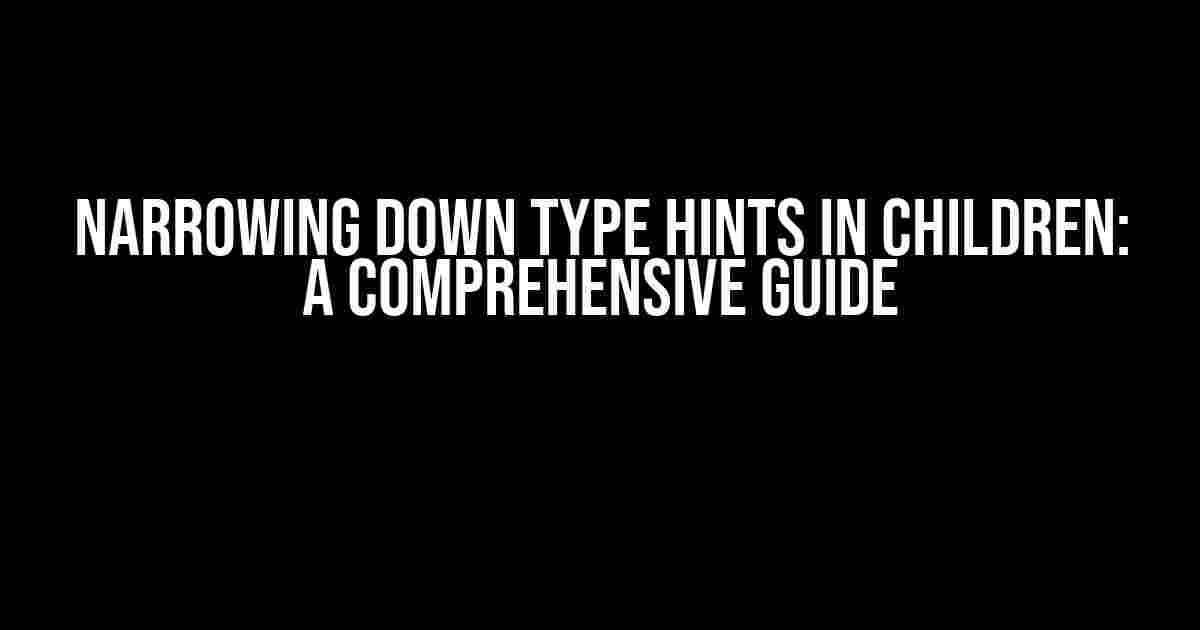When working with type hints in Python, one of the most common challenges is dealing with children classes that inherit from parent classes. In this article, we’ll explore the art of narrowing down type hints in children, providing clear instructions and explanations to help you master this essential skill.
What are Type Hints?
Type hints are annotations in Python that indicate the expected data type of a variable, function parameter, or return value. They were introduced in Python 3.5 as a way to improve code readability and help catch type-related errors. Type hints are not enforced at runtime, but they can be used by third-party tools and IDEs for code analysis and auto-completion.
The Problem with Inheritance
When creating a child class that inherits from a parent class, you often want to override the parent’s type hints to make them more specific. This is where narrowing down type hints comes in. Consider the following example:
from typing import List
class Animal:
def sound(self) -> str:
pass
class Dog(Animal):
def sound(self) -> str:
return "Woof!"
In this example, the `Animal` class has a method `sound()` that returns a `str`. The `Dog` class inherits from `Animal` and overrides the `sound()` method. However, the type hint for `sound()` in `Dog` is still `str`, which is not very specific. We can do better.
Narrowing Down Type Hints
To narrow down type hints in children, you can use the `Override` annotation from the `typing` module. This annotation indicates that a type hint is overriding a type hint from a parent class. Let’s revisit the previous example:
from typing import List, Override
class Animal:
def sound(self) -> str:
pass
class Dog(Animal):
def sound(self) -> Override[str, "Woof!"]:
return "Woof!"
By using the `Override` annotation, we’re telling the type checker that the `sound()` method in `Dog` is overriding the type hint from `Animal`. In this case, we’re specifying that the return type is still `str`, but with a more specific value, `”Woof!”`. This provides more information to the type checker and helps catch potential errors.
Using Type Aliases
Type aliases are a way to create a new name for an existing type. They can be particularly useful when working with complex types or when you want to provide a more descriptive name for a type. Let’s create a type alias for a `DogSound`:
from typing import TypeAlias
DogSound: TypeAlias = "Woof!"
Now, we can use the `DogSound` type alias in our `Dog` class:
class Dog(Animal):
def sound(self) -> Override[str, DogSound]:
return "Woof!"
By using the `DogSound` type alias, we’re providing a more descriptive name for the type, making our code more readable and maintainable.
Working with Generic Types
Generic types are types that can work with multiple types of data. They’re often used in containers like lists and dictionaries. When working with generic types, you can use the `TypeVar` annotation to specify the type parameters. Let’s create a generic `Pet` class that can work with different types of animals:
from typing import TypeVar, Generic
PetType = TypeVar("PetType", bound="Animal")
class Pet(Generic[PetType]):
def __init__(self, animal: PetType):
self.animal = animal
def sound(self) -> str:
return self.animal.sound()
In this example, we’re using the `TypeVar` annotation to specify a type parameter `PetType` that is bounded by the `Animal` class. This means that `PetType` can only be an `Animal` or a subclass of `Animal`. We’re then using the `Generic` annotation to specify that the `Pet` class is a generic class that takes a type parameter.
Narrowing Down Type Hints in Children with Generics
When working with generic classes, you can narrow down type hints in children by using the `TypeVar` annotation with the `bound` parameter. Let’s create a `DogPet` class that inherits from the `Pet` class and narrows down the type hint:
class DogPet(Pet[Dog]):
def sound(self) -> Override[str, DogSound]:
return self.animal.sound()
In this example, we’re using the `TypeVar` annotation to specify that the `DogPet` class is a specialization of the `Pet` class for `Dog` objects. We’re then narrowing down the type hint for the `sound()` method using the `Override` annotation.
Best Practices for Narrowing Down Type Hints
Here are some best practices to keep in mind when narrowing down type hints in children:
- Be specific**: When overriding type hints, try to be as specific as possible. This will help catch potential errors and improve code readability.
- Use type aliases**: Type aliases can help provide more descriptive names for types, making your code more readable and maintainable.
- Use the `Override` annotation**: The `Override` annotation is essential when overriding type hints in children. It helps the type checker understand the relationship between the parent and child classes.
- Test your code**: Make sure to test your code thoroughly to ensure that the narrowed-down type hints are correct and don’t introduce any errors.
Conclusion
Narrowing down type hints in children is an essential skill for any Python developer working with object-oriented programming. By using the `Override` annotation, type aliases, and generic types, you can create more specific and accurate type hints that improve code readability and maintainability. Remember to be specific, use type aliases, and test your code to ensure that your type hints are correct and effective.
| Keyword | Definition |
|---|---|
| Type Hint | An annotation in Python that indicates the expected data type of a variable, function parameter, or return value. |
| Inheritance | A mechanism in object-oriented programming where a child class inherits properties and behavior from a parent class. |
| Override | An annotation in Python that indicates that a type hint is overriding a type hint from a parent class. |
| Type Alias | A way to create a new name for an existing type, making code more readable and maintainable. |
| Generic Type | A type that can work with multiple types of data, often used in containers like lists and dictionaries. |
By mastering the art of narrowing down type hints in children, you’ll be able to create more robust and maintainable code that takes advantage of Python’s type system. Happy coding!
Frequently Asked Questions
Get clarity on narrowing down type hints in children with our expert answers!
Why is it important to narrow down type hints in children?
Narrowing down type hints in children is crucial because it helps reduce the complexity of code and makes it easier to maintain and debug. By specifying the exact type of a variable, you can avoid type-related errors and ensure that your code is more predictable and stable.
How do I determine the type of a variable in a child class?
To determine the type of a variable in a child class, you can use the `type()` function or the `isinstance()` function in Python. These functions allow you to check the type of a variable at runtime and ensure that it matches the expected type.
Can I use type hints in a child class to override the type hints in the parent class?
Yes, you can use type hints in a child class to override the type hints in the parent class. This allows you to specify a more specific type for a variable in the child class, which can be useful when you need to provide more precise type information.
What happens if I don’t provide type hints in a child class?
If you don’t provide type hints in a child class, the type hints from the parent class will be inherited. This means that the child class will use the same type hints as the parent class, which can lead to type-related errors if the child class has different type requirements.
Are type hints in children required for static type checking?
While type hints in children are not strictly required for static type checking, they are highly recommended. Providing type hints in children can help static type checkers like MyPy to perform more accurate type analysis and catch type-related errors earlier in the development process.


